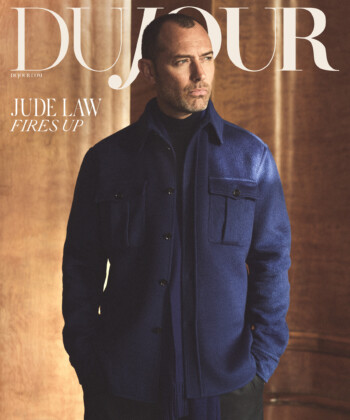Nonetheless, Rocha still worries about on-set pressure. “I get a little panicky. I come to work nervous because my contract has gotten bigger and bigger and bigger—I have to put everything in a clause now because I can’t trust people.… I’ve been beaten down so many times,” she says. “My list [of what I won’t do] compared with any other model’s is insane. No religious artifacts, no government artifacts. If I’m shooting with a male model, what is he exactly doing with me? What is he wearing? If I’m working with other models, what are they wearing? Are they playing something that I don’t want?”

At Zac Posen in 2012
Besides contracts, Rocha has found another way to have the last word: social media. In May, she was on the cover of Elle Brazil wearing what appeared to be a sheer top. She was furious. She’d actually worn a body suit underneath, but it had “been photoshopped out to give the impression of me showing much more skin than I was, or am comfortable with,” she wrote on her Tumblr blog. “This was specifically against my expressed verbal and written direction to the entire team that they not do so. I’m extremely disappointed that my wishes and contract were ignored. I strongly believe every model has a right to set rules for how she is portrayed, and for me these rules were clearly circumvented.”
Today, she says, “I didn’t want to make it a big issue, but I needed people to know and everyone I work with to know that this wasn’t OK.” She adds, “And I always feel like if I do something that I said I wouldn’t do, all those girls who look up to me will go, ‘She fell into being tempted. I’m not going to be able to do it.’”
Her fans responded with approval—and thanks to her husband, who manages her career, Rocha has throngs of followers: 1.8 million on Google Plus and nearly a half million on Twitter (where she tweets about daily life as a model and other oddities). Her 298,000 Instagram followers get to see her stream of behind-the-scenes photos from campaigns and photo shoots. “I was the first model to get a blog and talk about anything in modeling. Since I got to play around in this new, amazing world of social media, I get to stick around a lot a longer,” she says. “Usually a model gets two to three seasons, or a year and a half, and that’s it, you’re done. For me, it will be 10 years.”
While the size of her online following is impressive, Rocha says candidly, “Middle America probably has no idea who this Coco person is.” But if The Face proves successful, that will all change. “I think she’s going to get enormous exposure, and she’s very knowledgeable about how to use it to her advantage in this day and age,” says photographer Nigel Barker, the show’s host and a former judge on America’s Next Top Model.
Her job as a mentor on the show is a natural fit for Rocha. “If I ever had a bio on what Coco did for this industry, I would love it to say that Coco helped protect models and get them rights. When I was asked to be a part of The Face, I was like, ‘This is exactly what I do without cameras. I didn’t find it any different than what I usually do for young girls—giving runway tips or just explaining how the whole industry works—but now you have like 19 cameras on you, documenting you while you scratch your nose,” she says, laughing.
The television production process was a new and arduous experience for her. Filming lasted 37 days, often from early morning until late at night. Barker describes the dynamic among the cast as “a family that both loves each other and knows that it’s OK to say how much we hate each other. It was exciting and also hard, sometimes difficult and painful. We had explosions and personality clashes and arguments, as well as crying and laughing,” he says.
As the show’s premiere date nears, both he and Rocha are eager to share their project with the world. “You think you’re seeing the business from watching shows like Top Model, but it’s very much the opposite. What you’re going to get here is much more the heartbeat of the business—the soul of the business. It’s a real inside look into the model’s life, which we’ve never really seen before,” Barker says.

At the Met’s Costume Gala in 2010
Rocha is preparing herself for what the show’s exposure might mean for her career, but she isn’t letting it go to her head. “I do not take it for granted and think Oh, this is just my life now. It’s sooo fabulous. I mean, I used to watch America’s Next Top Model every Wednesday; I did not miss an episode,” she says. “And now I’m working alongside Nigel. It’s weird. All these people I never thought I would even meet, I’m now in close company with. It’s kind of crazy.”
She first met Barker two years ago when he photographed her and a group of more than 10 other leading models for a Nine West campaign that was in support of breast-cancer research and advocacy. For Barker, it wasn’t just Rocha’s looks that made her stand out. “Some of the models hadn’t bothered to learn why they were there or what the campaign was about,” he says. “But Coco had done all the work, and as a result, people went to her for interviews.” They’ve since worked together at least a dozen times. He calls Rocha’s moral stance “a very powerful statement for fashion” and says that as a mentor, she was able to show the aspiring models “you don’t need to take off everything in order to be exciting or mysterious.”
“It’s a big position for a model to take in an industry that is dominated by the idea of ‘sex sells.’ Fashion photographers are constantly getting the girls to take their clothes off, but Coco can actually put on more clothes and make it look sexier than the girl who is completely naked and putting her boobs in your face,” he explains. “She’s a smart girl. Her motivation, drive and confidence give her the ability to be so dynamic in front of the camera. That’s the reason she’s been so successful—it’s the reason people love her.”










































